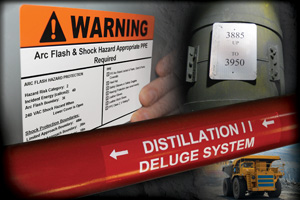Custom signs and labels
What are the benefits of custom site-specific signs and labels? And why don’t generic signs work?
Responding is Martin Carter, director of mining safety and visual communications, Graphic Products Inc., Beaverton, OR.
 No matter how well you’ve attended to safety, going through a mining safety inspection is a bear. That’s why safety- and budget-conscious mines all create safety labels onsite with thermal transfer printers.
No matter how well you’ve attended to safety, going through a mining safety inspection is a bear. That’s why safety- and budget-conscious mines all create safety labels onsite with thermal transfer printers.
Mine equipment operators, mill operators and maintenance personnel face dangers every day, but traditional safety sign ordering methods are costly and too slow to make an immediate impact on safety. Many environmental, health and safety managers dig through thick catalogs in search of just the right sign with the correct dimensions, colors and CSA- and WorkSafe BC-compliant language. Requisitions slow the process further.
Ordering custom signs from sign shops is expensive and slow – especially for delivery to remote locations. You will wait weeks and weeks – nearly forgetting you ordered the signs in the first place. Sound familiar? This process hinders getting signs up quickly or at all, especially when you have to buy 20 or 30 signs to get a price break, even though you only needed a couple.
The good news? Thermal transfer printers may be ordered directly and delivered overnight to remote sites. Immediately, you can create all the signs and labels you need and to perform anywhere in and around a mine. Thermal transfer printers use heat to literally “bake” on graphics and text to vinyl and other supplies that have been tested to perform under the most demanding conditions.
Signs and labels impact every inch of your mine. There’s a good chance you’ll need traffic signs, facility signs, no smoking or cell phone signs, mine permit boundary signs, and identification tags for exploration, as well as valve tags and arc flash NFPA70E signs.
Marking tools with colors, numbers and bar codes reduces theft and loss. Color-marking hard hats and equipment differentiates shifts and departments, keeping people, as well as tools, in their sector. When short-term electrical outages occur, signs that are visible in the dark help people find their way.
Generic signs don’t cut it
Signs and labels that are site-specific to company policy make all the difference for new hires, visitors and subcontractors. Multilingual signs support a global workplace encompassing Africa, Europe, Australia, Asia, and North and South America.
Call it the autonomy of the label printer. You control when and how frequently you create signs and labels. You see an incident waiting to happen, zip right back to your desk, print out a sign and post it on the spot. No waiting for approval. No paperwork to fill out. No injury or worse.
Editor’s Note: This article represents the independent views of the author and should not be construed as National Safety Council endorsements.
Post a comment to this article
Safety+Health welcomes comments that promote respectful dialogue. Please stay on topic. Comments that contain personal attacks, profanity or abusive language – or those aggressively promoting products or services – will be removed. We reserve the right to determine which comments violate our comment policy. (Anonymous comments are welcome; merely skip the “name” field in the comment box. An email address is required but will not be included with your comment.)

